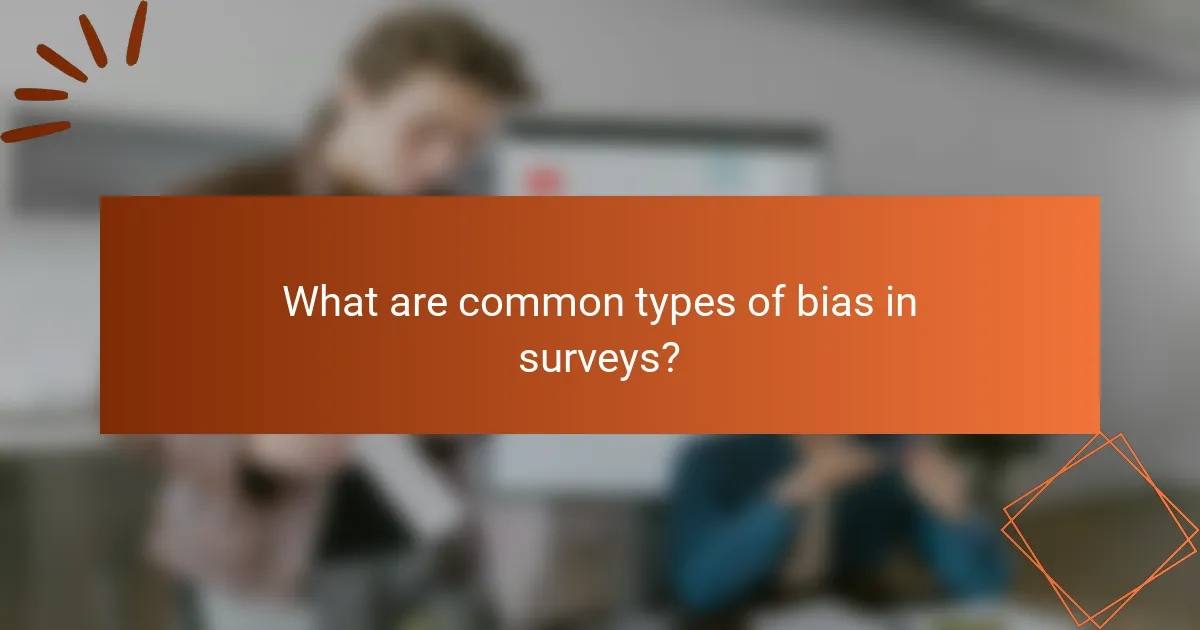Bias in survey questions can significantly impact the accuracy and reliability of the data collected. To mitigate this issue, it is essential to frame questions neutrally and employ techniques that encourage honest responses. By utilizing mixed-method approaches and conducting thorough pilot testing, researchers can enhance the validity of their findings and ensure a more trustworthy survey process.

How to avoid bias in survey questions?
To avoid bias in survey questions, it is crucial to frame questions in a way that does not lead respondents toward a particular answer. This involves using neutral language, pre-testing questions for potential bias, and implementing techniques that promote honest responses.
Use neutral language
Neutral language is essential for minimizing bias in survey questions. Avoid emotionally charged words or phrases that could sway respondents’ opinions. For example, instead of asking, “How much do you dislike our product?”, rephrase it to “What is your opinion of our product?”
Additionally, ensure that the wording is straightforward and free from jargon. This helps all respondents understand the questions similarly, leading to more reliable data. Aim for clarity and simplicity to enhance the accuracy of responses.
Pre-test questions for bias
Pre-testing survey questions can identify potential biases before the survey is distributed. Conduct pilot tests with a small, diverse group to gather feedback on how questions are interpreted. This process can reveal any leading or confusing language.
During pre-testing, ask participants about their thought processes when answering each question. This feedback can help refine questions to ensure they elicit unbiased responses. Aim to adjust questions based on this feedback to improve overall survey quality.
Implement randomized response techniques
Randomized response techniques can help mitigate bias by allowing respondents to answer sensitive questions more honestly. This method involves providing participants with a random mechanism, such as a coin flip, to determine whether they answer the sensitive question or a neutral one.
For example, if a survey includes a question about illegal activities, respondents might feel uncomfortable answering directly. By using a randomized approach, you can encourage more truthful responses while maintaining confidentiality. This technique can significantly enhance the reliability of sensitive data.

What techniques improve accuracy in surveys?
Improving accuracy in surveys involves using methods that minimize bias and enhance the reliability of responses. Techniques such as mixed-method approaches and validated scales can significantly contribute to obtaining precise and trustworthy data.
Employ mixed-method approaches
Mixed-method approaches combine qualitative and quantitative research techniques to enrich survey results. By integrating open-ended questions with structured items, researchers can capture nuanced insights while maintaining statistical rigor.
For example, a survey might include multiple-choice questions to quantify responses and follow up with open-ended questions for deeper understanding. This combination can lead to a more comprehensive view of respondents’ opinions and experiences.
Utilize validated scales
Using validated scales ensures that the survey measures what it intends to measure, enhancing the accuracy of the results. These scales have undergone rigorous testing for reliability and validity, providing a solid foundation for data collection.
For instance, employing a well-established scale like the Likert scale can help gauge attitudes effectively. It’s crucial to select scales that are relevant to the target population and context, as this increases the likelihood of obtaining meaningful and actionable data.

How to ensure reliability in survey results?
To ensure reliability in survey results, it is essential to implement systematic techniques that enhance the consistency and accuracy of responses. This includes conducting pilot testing and analyzing internal consistency to identify potential biases and improve the overall quality of the survey instrument.
Conduct pilot testing
Pilot testing involves administering the survey to a small, representative sample before the full rollout. This step helps identify unclear questions, technical issues, or biases that may affect responses. Aim for a pilot group that mirrors your target audience to gather relevant feedback.
After conducting the pilot, analyze the responses to determine if the questions yield consistent results. Adjust any problematic items based on participant feedback to enhance clarity and reliability. A typical pilot test might involve 10-30 respondents, depending on the survey’s complexity.
Analyze internal consistency
Internal consistency measures how well the items in a survey correlate with each other, indicating whether they are assessing the same underlying construct. Common methods include calculating Cronbach’s alpha, where a value above 0.7 generally suggests acceptable reliability.
To analyze internal consistency, review the correlation between responses to similar questions. If certain items show low correlation, consider revising or removing them. This analysis can significantly enhance the reliability of your survey results, ensuring that the data collected is both accurate and trustworthy.

What are common types of bias in surveys?
Common types of bias in surveys can significantly distort results, leading to inaccurate conclusions. Understanding these biases helps in designing better surveys and interpreting data more reliably.
Leading questions
Leading questions are designed to guide respondents toward a particular answer, often reflecting the survey creator’s bias. For example, asking “How much do you love our product?” implies that the respondent should have a positive view, which can skew results.
To avoid leading questions, frame inquiries neutrally. Instead of suggesting a positive response, ask open-ended questions like “What are your thoughts on our product?” This encourages honest feedback and reduces bias.
Social desirability bias
Social desirability bias occurs when respondents answer questions in a manner they believe will be viewed favorably by others. This often leads to over-reporting positive behaviors or under-reporting negative ones, affecting the accuracy of the data.
To minimize social desirability bias, consider using anonymous surveys or indirect questioning techniques. For instance, instead of asking directly about sensitive topics, you might ask about general trends or perceptions in a group.
Acquiescence bias
Acquiescence bias, or “yea-saying,” happens when respondents tend to agree with statements regardless of their true feelings. This can lead to inflated agreement rates and misinterpretation of attitudes.
To counteract acquiescence bias, include a mix of positively and negatively worded statements. This encourages respondents to think critically about their answers and provides a more balanced view of their opinions.

How does bias affect survey outcomes?
Bias can significantly skew survey outcomes by leading respondents toward specific answers, ultimately distorting the data collected. This distortion can result in misleading interpretations and conclusions that do not accurately reflect the true opinions or behaviors of the target population.
Distorts data interpretation
When bias is present in survey questions, it can lead to a misrepresentation of the data. For example, leading questions that suggest a preferred answer can cause respondents to select options that do not reflect their true feelings. This can result in inflated or deflated perceptions of trends and opinions.
To mitigate this distortion, surveys should employ neutral wording and balanced response options. For instance, instead of asking, “How much do you agree that our service is excellent?” a more neutral phrasing would be, “How would you rate our service?” This approach allows for a more accurate representation of respondents’ views.
Reduces trust in results
Bias in survey questions can erode trust in the results among stakeholders and participants. When respondents perceive questions as leading or unfair, they may doubt the validity of the findings, which can undermine the entire survey’s credibility. This skepticism can lead to lower response rates in future surveys.
To build trust, it is essential to ensure transparency in the survey design process. Providing clear explanations about how questions were formulated and how data will be used can enhance respondents’ confidence in the survey’s integrity. Regularly reviewing and updating survey methodologies can also help maintain trust over time.

What frameworks help assess survey quality?
To assess survey quality effectively, frameworks like the Total Survey Error framework and the Dillman Method provide structured approaches. These frameworks help identify potential sources of error and improve the overall reliability and validity of survey results.
Use the Total Survey Error framework
The Total Survey Error framework encompasses all possible errors that can occur during the survey process, including sampling, measurement, and nonresponse errors. By understanding these categories, researchers can pinpoint where improvements are needed to enhance data quality.
Key steps in applying this framework involve identifying potential errors at each stage of the survey process, from design to data collection and analysis. For instance, ensuring a representative sample can significantly reduce sampling error, while clear and unbiased questions can minimize measurement error.
Apply the Dillman Method
The Dillman Method focuses on optimizing survey design and administration to increase response rates and data quality. It emphasizes the importance of clear communication and respondent engagement throughout the survey process.
Practically, this method suggests using personalized invitations, follow-up reminders, and multiple modes of survey administration (e.g., online, mail, phone) to reach a broader audience. For example, studies have shown that personalized emails can increase response rates by a notable percentage compared to generic requests.

What role does question wording play in surveys?
Question wording is crucial in surveys as it directly affects how respondents interpret and answer questions. Clear, unbiased wording can enhance the accuracy and reliability of survey results, while poorly constructed questions can lead to misunderstandings and skewed data.
Affects respondent understanding
The way a question is phrased can significantly impact how respondents comprehend it. For example, using technical jargon or complex language may confuse participants, leading to inaccurate responses. It’s essential to use simple, straightforward language that aligns with the target audience’s knowledge level.
Additionally, the order of words can change the meaning of a question. For instance, asking “How often do you exercise?” may yield different responses than “Do you exercise regularly?” The former implies frequency, while the latter suggests a habitual action. Ensuring clarity in wording helps maintain consistent understanding across respondents.
Influences response patterns
Question wording can shape the patterns of responses collected in a survey. Leading questions, which suggest a particular answer, can bias results. For instance, asking “Don’t you agree that our service is excellent?” may prompt a more favorable response than a neutral question like “How would you rate our service?”
Moreover, the use of positive or negative framing can alter how respondents feel about a topic. For example, “What do you like about our product?” versus “What do you dislike about our product?” can lead to different insights. To minimize bias, it’s advisable to balance positive and negative phrasing and to test questions for potential bias before deploying the survey.

How can technology mitigate survey bias?
Technology can significantly reduce survey bias by employing advanced methodologies and tools that enhance question design and data collection. Automated systems can analyze responses in real-time, ensuring that questions are clear and unbiased, while machine learning algorithms can identify and correct patterns of bias in survey data.
Utilizing Randomization Techniques
Randomization is a powerful method to mitigate bias in surveys. By randomly assigning respondents to different question orders or response options, researchers can minimize the influence of question framing on answers. This technique helps ensure that the data collected is more representative of the population.
For example, in a survey about consumer preferences, randomizing the order of product options can prevent early options from receiving undue attention, leading to more balanced responses. Implementing randomization can be easily done through online survey platforms that offer this feature.
Implementing Adaptive Questioning
Adaptive questioning tailors survey questions based on previous responses, enhancing relevance and clarity. This method can help reduce bias by ensuring that respondents are only asked questions pertinent to their experiences and opinions, thus avoiding confusion or frustration.
For instance, if a respondent indicates they do not use a specific product, subsequent questions about that product can be skipped. This approach not only improves the quality of data but also respects the respondent’s time and engagement.
Leveraging Data Analytics for Bias Detection
Data analytics tools can identify potential biases in survey responses by analyzing patterns and inconsistencies. By examining demographic data alongside responses, researchers can spot trends that suggest bias, such as overrepresentation of certain groups or skewed response patterns.
For example, if a survey shows that a particular demographic consistently rates a product lower than others, this may indicate a bias in how questions are framed. Utilizing analytics software can help researchers adjust their questions or sampling methods to achieve more accurate results.


